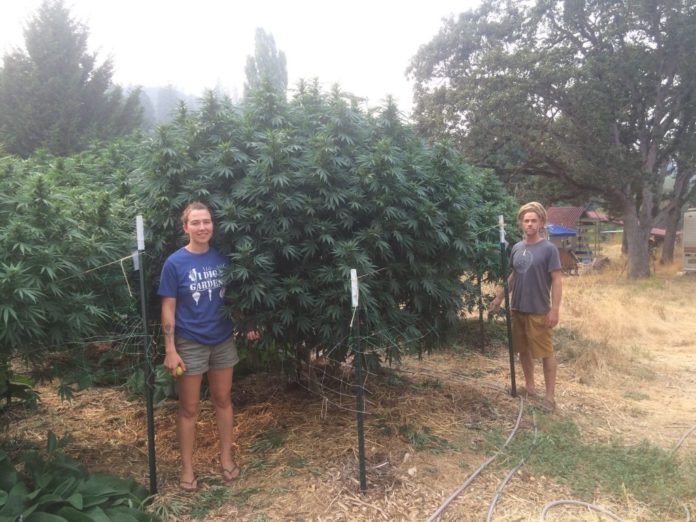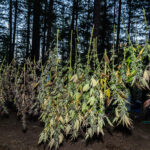Driving through a lush forest of what looks like a tropical mountain paradise, the sky is hazy. But the haze is not from mist, its smoke from wildfires. And I’m not in the tropics, I’m in southern Oregon, heading toward the farm at Green Source Gardens, a licensed medical marijuana producer.
When I arrive, Green Source owners Nick and Elizabeth Mahmood tell me all the green life in the area is because the climate is perfect for vegetation. The long, dry summers are friendly to the cannabis plant. The wet, but not freezing, winters allow the soil to compost year-round.
There’s not an inch of bare soil at Green Source Gardens. Hay crunches beneath my feet as we walk through the farm. Nick plucks a pear from a tree and hands it to me to eat. Hops and bamboo grow alongside the perimeter fence. Behind that fence I can hear goats bleating. Elizabeth tells me the goats create an additional “stink fence,” somewhat shielding the scent of cannabis from neighbors.
The philosophy at Green Source Gardens is that biodiversity is the key to creating rich soil and top-grade plants. Nine thousand Instagram followers might agree. “This one got 600 likes,” Nick says as we walk past a Pinkleberry strain. “We do all the pollinating and breeding. We collect all the pollen and then choose to breed with different varieties that we like. This is a particularly good variety based on how it finishes early, so I breed it with all kinds of stuff. I want early finishing traits along with all these other characteristics. For the outdoor grower, to be able to more reliably be in late September rather than late October gives you a much better chance of maximum yields.”
They call their method eco-dynamic, no-till soil stewardship. “It’s pretty mind-blowing what can be done without any of the stuff people think you need in order to do it,” says Nick. “It changes the perception of what’s possible in agriculture. Tilling the soil and digging around is not doing any good for the evolution of the maturation of the soil ecology.” Green Source Gardens tries to operate as much as possible as a closed-loop system. Manure from their animal pens is a major component. “We’ve got all the animals we take care of and when you think of all the little bugs in the soil, those are all our livestock as well. The work is just bringing them their food, and they, in turn, feed the plants,” Elizabeth explains. Goats are fed whole grains and sunflower seeds mixed with organic kelp. “It makes all the poop that comes out of them like gold, because there’s nothing skanky in there.”
In between two cannabis plants is a low-to-the-ground comfrey. Nick picks off some comfrey leaves and spreads them around the base of a cannabis plant, which he describes as a typical feeding regimen. Green Source grows its own mulch in the form of comfrey plants and also buys woodchips from industries that produce them as a byproduct. The mulch breaks down over time and reduces the need to buy new soil. “All it takes is a log of organic matter, good fungal growth, and strategic plantings of plants that do their job really well, which is recover nutrients and bring them into the physical form that then is really wonderful feed for the other plants,” Nick says.
Readers familiar with NPK ratios will appreciate that, according to Nick, wood is good for fungus and creates phosphorous, while grass and manures are food for microbial bacteria and release nitrogen. Nick and Elizabeth brag about the many species of mushrooms and predacious bugs on the farm. Another benefit of all the different species is protection against disease and disaster. According to Nick’s cousin Daniel, who helps out on the farm, “In any monoculture, one thing can come in and devastate it, like with potato famine. We want everything here to be a huge competition. It’s like The Hunger Games out here with the insects and everything.” Elizabeth adds a specific example: “Take a predacious soil beetle. They’re a very delicate species, and they don’t show up unless it’s a very healthy environment. If you’re seeing multiple species of predacious soil beetles, then you know you’re doing great because you have a diversity of top predators, which is then going to ensure you have more of a defense against a diverse base of pests. It’s just like any healthy ecosystem: The more diversity you have of all different tiers of the food system, the more stable it’s going to be.”
Nick takes pride in how they deal with challenges that come up: “When we see powdery mildew, we just pick it off. You don’t freak out and spray a bunch of stuff. We keep the airflow really good. You do preventative, real simple things like picking it off or moving something or culling a plant and not freaking out and treating the whole garden for powdery mildew and spraying.
“We have mites, and if you look in the right places you should find mites, and that should be how you address a healthy garden is to keep the bugs in their right zone,” he continues. “They shouldn’t be eating your buds. That means the plant’s sick, and that’s probably a human-induced issue due to overfeeding and overwatering and pushing plants too hard. There should always be mites in these leaves that aren’t getting any sun.” We walk by a patch of mint plants that are swarming with pollinating bugs.
Green Source Gardens has applied for a recreational license and is looking at new property to expand their operation. They’d like to be able to serve more customers and continue using their practices. “It would be an amazing example,” says Nick.
Nick started his agricultural career in Prescott, Arizona, doing urban agriculture projects. He’d been travelling around the wilderness and was sick of relying on buying food so, “I just committed to growing my own food.” He farmed in people’s yards around the city and sold to restaurants, through farm stands, and through community supported agriculture. “I rode my bike around town and took care of nine of these gardens at a time,” he says. “I’d deliver food to a restaurant Elizabeth was working for.” That’s how they met.
Nick and Elizabeth hope to educate people to trust in natural processes as Americans did before industrial agriculture. “We want to teach people processes that actually work and also help heal the place and take care of the land instead of destroying it and leaving the space in worse condition,” says Elizabeth. The couple believe they are making their soil more fertile every year. “This space is going to act as a nursery for the next space,” says Nick. “These gardens become super valuable in that they can plant other gardens. If we don’t end up growing cannabis here, it will end up being an orchard and a very productive and beautiful space as well.”










